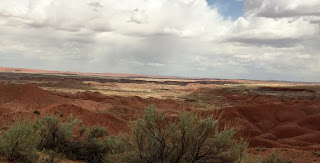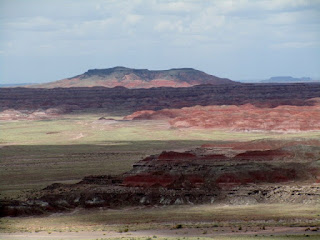USA RV Park was a beautiful and welcome stop.
Just across the border in Arizona is the Painted Desert and Petrified Forest. We took off the next morning and drove about an hour to the entrance for both parks. The road starts by taking you through the southern corner of the Painted Desert, then turns south and continues through the Petrified Forest. As with the other places we have visited, the drive through isn't long, but the pull-offs for viewing vistas, and trails you can take, mean you can spend quite a bit of time there.
We left the Painted Desert and continued on through the Petrified Forest.
When I was a little girl, I envisioned a forest that one could walk through, of tall, stately trees. I would have been confused by the term 'forest' for what resembled the left overs after a lumber company had cleared a hillside. By now, I knew that wasn't the case, but the 20 minute video in the Visitor's Center really helped me understand the story behind the forest. In a nutshell, (and with little geological background), in the Late Triassic period the trees once did stand tall. The climate was tropical. Trees that had fallen in river and stream beds were often covered in silt containing volcanic ash. The silica in the ash replaced much of the original wood, but retained the cell structure so the trees themselves became rock containing quartz structures.
Petrified wood can be found in all 50 states. This place just has a large concentration of it and therefore has been set aside as a place to study, explore, and leave untouched.
The Petrified Forest also exposes life from those that followed the Triassic period.There were several places where we could see petroglyphs, an ancient form of communication, that has stood the test of time. Petroglyphs are pictures carved into the rock, using a stone chisel, that early peoples used to communicate. They may be a way of communicating a great warrior's accomplishments, or signs that many people traveled through an area. Some petroglyphs may be a sign of stair steps, climbing or just a decoration, like the ones pictured below.
 |
| There are 2 Petroglyphs in the top left of the darkest part of the rock, (Just upper left of center) |
 |
| Bird holding a frog. Was this a good place to fish? |
 |
| This is the Equinox Rock. The petroglyph that marks it is hard to see, but was visible from a distance. |
 |
| The square with the C in the middle that looks like a 'copyright' symbol is the Equinox mark. |
 |
| This diagram illustrates the progression of the sun on the rock. |
We think of ourselves as a superior culture, and it's true, we have gone to the moon. But these people knew the world they lived in better than the majority of those of us inhabiting this same world, today. Amazing!
There were fields with chunks of logs lying on the ground that looked as if a chain saw had been taken to them, (reinforcing my image of a pre-historic lumber company clearing the land).
 |
| Look Closely! There is a log sticking out of the rock just to the left of center in this photo. |
It was a neat place to go and see prehistoric history.
Along with the pre-historic world, there were signs of a more modern time. The famous Route 66 once traveled through this area before the land was designated as a national park in 1962.
 |
| This car stands as a monument to Route 66 |
 |
| The original stagecoach stop has been rebuilt on the original site. |
 |
| Ruins of a Pueblo Village |
This was our first introduction to the history and development of the Anasazi (or ancient peoples that later became the Pueblo people), but not the last. This was their land and we are now the explorers on it.


















No comments:
Post a Comment